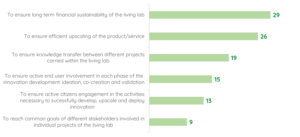Evaluating living labs, challenges and identified needs
There are many types of living labs. Depending on their overall objectives, functioning, and given local circumstances, they differ in set up and obtained successes. Nevertheless, based on the EIT Urban Mobility living lab inventory some overall conclusions can be drawn in terms of generic challenges and identified needs.
Ensuring the long term financial sustainability of the living lab, as well as the efficient upscaling of products and services, were indicated as the two most important challenges by the majority of living labs. Next, living labs led specifically by universities and private-public partnerships consider fostering knowledge transfer between individual living labs a real challenge. Finally, end user and citizens engagement is considered the fourth most important challenge in relation to the operation of mobility living labs.
Description
Achieving the common goals of the stakeholders involved in the living labs and their projects is generally considered tricky but in reach. On the other hand, almost two thirds of the living labs analyzed perceive that ensuring long-term financial sustainability is a real challenge. The second major challenge identified among the living labs community is how they can ensure the efficient upscaling of tested products and services.

At the core of most living lab activities, ensuring knowledge transfer between the different projects is considered a demanding task by slightly less than half (40%). Ensuring end user active involvement in all co-creation stages, as well as ensuring citizens active engagement, demands a lot of efforts.
Moreover, some living labs have indicated that the development of a well-developed software for data collection (which is often the primary infrastructure for living lab activities) and the establishment of planning and procurement policies are additional areas of challenge.
In the initial phase of development, living labs specifically seem to have operational challenges. To overcome them, they focus on becoming more structured, aligning the objectives and values of the main stakeholders. Many efforts are made to develop a roadmap, as well as to establish sustainable business models. Next to this, they seek to trigger different partners to engage with the living labs, experimenting in collaborative environments with different stakeholders of the urban mobility ecosystem.

Once the living labs are established, the challenge is to maintain and further develop their main added value for companies and innovation projects. Engaging new partners in living labs is often necessary to guarantee the sustainability of the business model. Being able to facilitate the permissions and administrative barriers required to engage with end users/citizens and keep people engaged throughout the living lab experiments is a continuous process, which requires maintaining the cooperation with the key stakeholders of the urban mobility ecosystem.

Another critical aspect for the established living labs is to maintain the retention rate of the companies that are customers of the living lab and, in general, to maintain their engagement in the living lab processes.
Living labs need to remain interesting to the participating stakeholders, stay on the top of the on-going policy, regulatory and innovative developments, and have a good understanding of the local mobility market and stakeholders. Operationally advanced living labs are also exploring more structured frameworks and methods of rolling up and upscaling of the solutions developed within the living labs. For the project-based living lab experiments, the additional challenge is to keep the established community active outside and beyond the project funding.
The focus on the key areas of support for the set up, operation and management of the living lab slightly differs per living lab “owner”: while university, research entity, industry and public-private partnership led living labs would benefit from support in the financial sustainability of the living lab and its financial model, public authorities, as living lab owners, would additionally benefit from support in the development of the living lab roadmap.
Possible support for the living labs
The majority of the living labs analyzed would be interested in being part of the structured network of mobility living labs. They have indicated that sharing best practices and facilitating the upscaling of developed innovations can be one of the added values of such a network.

To enable living lab projects, innovations, and start-ups to contribute on a larger scale to EU and local targets, successful living labs, as well as their tested innovations, could be supported with access to investors and available EU funding and financing, but also new forms of funding sources, such as sustainable and social impact funds.
To accelerate the scaling up of successful living labs innovations, the EIT Urban Mobility could enable and assist the living labs through, for example, dedicated City Club based scale-up programs. This would allow the living labs to bring the developed products, services, and start-ups more effectively to the urban mobility market and bridge the gap between the initial testing and the large roll out of the innovations.
The EIT Urban Mobility, and in particular its City Club, could play a key role in enabling the transfer of knowledge and results of tested living lab solutions. Establishing close cooperation with existing living labs would allow other cities, practitioners, experts, business developers and entrepreneurs to transfer and scale up the successful innovations.
References
(1) EIT Urban Mobility Knowledge base of innovative solutions in urban mobility and living labs, Final Report, Deliverable 4, Authors: Nesterova, N., Uzunova, E. (BUas); Egmond, P. van, (LuxMobility), December 2020.
Download as PDF